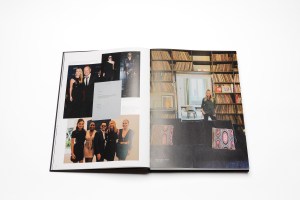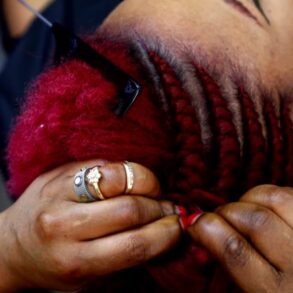MILAN — While not an autobiography in the classic sense of the word, there is a lot of Frida Giannini in the new Rizzoli book “A Journey Into the Style and Music of My Icons Since 1969.”
“This is a very personal project on which I worked for the past two years, but I always wanted to write about the influence of music on fashion, since I was at the Accademia [di Costume e Moda in Rome] as my thesis,” Giannini told WWD ahead of her trip to New York, where she will unveil the book at the Rizzoli store on Tuesday.
“This is a book on my great passions, fashion, music and art,” explained Giannini, who was Gucci’s creative director for a decade until 2015. Before that, from 1994 to 2001, she worked at Fendi, first as a ready-to-wear designer and then in charge of accessories.

The cover of Frida Giannini’s book.
For the book, for the first time, the designer drew portraits of her idols and muses, from David Bowie, Diana Ross and Eric Clapton to Tina Turner, Grace Jones, Aretha Franklin and Mick Jagger, to name a few, shown in the last pages of the 240-page tome. The Icons portraits will be auctioned and proceeds will be donated to the nonprofit organization To.Get.There, whose work is aimed at protecting orphans and children affected by HIV in Uganda and South Sudan.
Bowie, in particular, has been a key influence in Giannini’s life. She refers fondly to her late uncle Daniele Vellani, a drummer and DJ in the 1970s and 1980s, who instilled in Giannini a love of music. She reckons she now has 8,500 music LPs, many inherited from her uncle. Vellani turned her into a fan of David Bowie when she was a child and, over the years, she went on to become a collector of Bowie records, books, and photos from around the world. “My dream was to be a rock star but my voice is terrible,” Giannini said with a chuckle.

Photos in the book of Frida Giannini with Sting in 2013; with Camilla Belle, Mary J. Blige, Marc Anthony and Jennifer Lopez in 2011 and in her music room in Rome in 2021.
The idea of the book came from Vellani’s close friend, music producer and DJ Corrado Rizza, who wanted to interview Giannini on anecdotes about Bowie.
Giannini was so fascinated by Bowie that when he died in 2016 she received countless messages and phone calls of condolences, “as if he were a close relative of mine. For me it was truly a day of mourning,” she recalled.
The book allows Giannini to run through the history of music from 1969 to today, from Joan Baez and Jimi Hendrix to Kurt Cobain, Madonna and Lady Gaga, among some, as an interpretation of fashion and society. She chose 1969 as the starting point, the “Big Bang” of music, citing the Woodstock festival, “Space Oddity,” Bowie and the first crewed mission to land on the Moon that year.
“In those days, in 1969, it was a time of total revolution in style, mental freedom, and Bowie was an example of all this, to the extent that we all remember the jumpsuits, the turquoise suits with bell bottoms, his fitted jacket with a striped tie, and his red hair, short in the front and long at the back. There’s also the Yamamoto period, which was the only collaboration he did, the first and last.
“For my thesis at the Academy, I talked about David Bowie the whole time, and I said that for me he set an example, because he invented and created his own look. At a certain point he found Yamamoto to be an interesting partner, but I’m sure it was a mutual collaboration. I’m sure that David designed what he wanted together with Yamamoto. In one biography I learned that his famous Lurex jumpsuit became iconic because before going on stage he cut one of the legs.”
In 2013, Gucci partnered with London’s Victoria and Albert Museum on the “David Bowie is” exhibition, shining a light on the style of the musician, whose imaginative guises — from Ziggy Stardust and the Thin White Duke to Aladdin Sane — provided inspiration for designers.
Giannini herself designed a collection called “Glam Rock” for Gucci that was inspired by Bowie, which included a two-piece blue suit with boots and platform heels and a tie, the outfits with diagonal stripes. She described him as “both chic and extreme” and “incredibly ingenious. And there isn’t a single one of David Bowie’s looks that we don’t all remember. Not just in the imagination of a creative person who is also inspired by his work. But there’s no comparison. I love all kinds of music. I’ve never been a snob when it comes to music.”
The V&A show comprised more than 300 objects, including handwritten lyrics and set lists, original costumes, photographs, diary entries and musical scores.
Unfortunately, Giannini never had the opportunity to personally meet Bowie, although she met many musicians over the years, connecting them to Gucci, from Madonna to Beyoncé Knowles-Carter. With the latter and Salma Hayek Pinault, the designer staged a concert at London’s Twickenham Stadium in 2013 for Chime for Change, rolling out acts including Jennifer Lopez, Florence and the Machine, Ellie Goulding, and John Legend, to name a few.
In one of the photos in the book, Giannini is seen with Mick Jagger and she writes, “I had my hand over my heart because I thought I’d have a heart attack. There are legends that will always be legends.”
Giannini’s personal history unfolds through the pages together with the different music movements and the evolution of clothes, hairstyles and society. The chapters range from “Revolutionary Women,” with Carole King cited as an inspiration to become involved in human rights and organize the Chime for Change concert in 2013, to “From Soft Rock to Metal,” with Guns N’ Roses, led by Axl Rose.
“He laid down the law on the matter of trends (their crown of thorns is probably one of the most merchandised logos ever, along with Mick Jagger’s tongue) and looks: who can forget his blond hair and pirate bandana, a baseball cap worn backward, as well as Scottish or leather kilts, combat boots or Dr. Martens?” writes Giannini, recalling his “crazy relationship” with supermodel Stephanie Seymour.
Among some of the examples of influential looks, she cites Diana Ross and Michael Jackson, with their “eccentric style verging on kitsch”; The Cars’ Ric Ocasek, who “always wore a black jacket, thin tie and bangs stuck to his forehead”; David Byrne of Talking Heads, “with his Elvis Presley pompadour hairstyle and one eye on British dandy style,” and Sting, Patti Smith and Lou Reed wearing “mariner” striped shirts. Madonna of course was a key inspiration for Giannini herself, whose first movie she saw as a teenager was “Desperately Seeking Susan,” and who at 15 dyed her hair and wore lace gloves and leggings to imitate the artist in the “Like a Virgin” video.
The heir to Bowie as far as chameleon-like transformations? Lady Gaga, Giannini said without a doubt.
The designer combed through hundreds of photos and she underscored she wanted to run “unusual and special” images, to avoid that déja-vu feeling, and that would relate to specific and key moments in history, including Muhammad Alì standing over Sonny Liston in Lewiston in 1965 or an impressive aerial view of the Woodstock music and art fair in 1969.
Giannini continues to consult with fashion brands but has also become a majority shareholder in a bistrot and in a travel agency in Rome, creating the interior design for the locations.
The book retails for 80 euros.
This post was originally published on this site be sure to check out more of their content.








